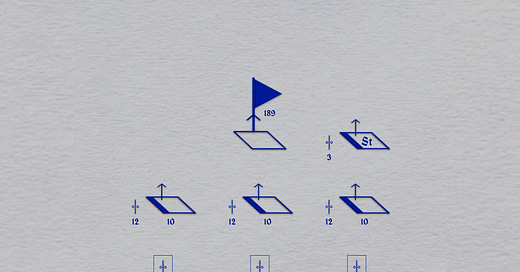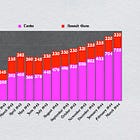In April of 1943, the 78th Assault Division [78. Sturm Division] formed an assault gun escort company [Sturmgeschütz Begleitkompanie] for Assault Gun Battalion 189 [Sturmgeschütz Abteilung 189]. As the name implies, the escort company provided teams of men armed with infantry weapons to protect assault guns from the many invisible dangers they faced while fighting on the Eastern Front. (These included land mines, sapper squads, impassable terrain, and massed anti-tank rifles.)
Each of the three platoons of the escort company was designed to work closely with a particular assault gun battery. Similarly, each of the three squads of each escort platoon was tailored to the task of cooperating with a three-vehicle assault gun platoon.
The headquarters of the escort company consisted of two men: the company commander and an engineer who served both as the first sergeant [Hauptfeldwebel] and the “duty expert” on all things related to obstacles, explosives, and, most especially, anti-tank mines.
The absence of messengers and communicators in the headquarters company resulted from the close connection between elements of the escort company and the assault gun units that they supported. Thus, if the commander of the escort company, or the leader of one of the escort platoons, wished to send a message, he could use the radio in a nearby assault gun.
The three pioneers in each escort platoon came from the combat engineer battalion of the 78th Assault Division. The three pathfinders [Pfadfinder], who ranked as corporals [Gefreite] or sergeants [Unteroffiziere] were seconded from assault gun batteries. (While the pioneers were chiefly concerned with helping assault guns avoid anti-tank mines, the pathfinders guided armored vehicles through difficult terrain.)
The rest were soldiers who had previously been assigned to the 1st Company of the division’s Training School [1./Ausbildungs Schule]. True to its name, the Training School was a unit in which soldiers with a variety of backgrounds - recruits fresh from their training regiments in Württemberg, veterans recovering from their wounds, and soldiers “combed” from non-combat units - learned the peculiar art of fighting on the Eastern Front.
The training of the escort company included techniques for protecting assault guns against sappers; using artillery and the fire of various infantry weapons to suppress antitank gunners and antitank riflemen; liaison between assault gun units and infantry units; the use of signal flares fired from pistols; locating mine fields and negotiating important terrain features (trenches, creeks, bridges, bogs, cliffs); reinforcing bridges, roads, and pieces of ground so that they might support the weight of assault guns; and the recovery of crippled assault guns.
The escort company possessed no vehicles of its own. Thus, the men of the unit usually rode into battle on the backs of assault guns.
Source: 78. Sturmdivision, Ia, “Sturmgeschütz-Begleitkompanie”, 22/4/43. U.S. National Archives, Microfilm Series T-315, Roll 1100, Frames 164-165
For Further Reading:









